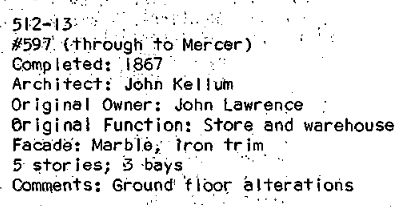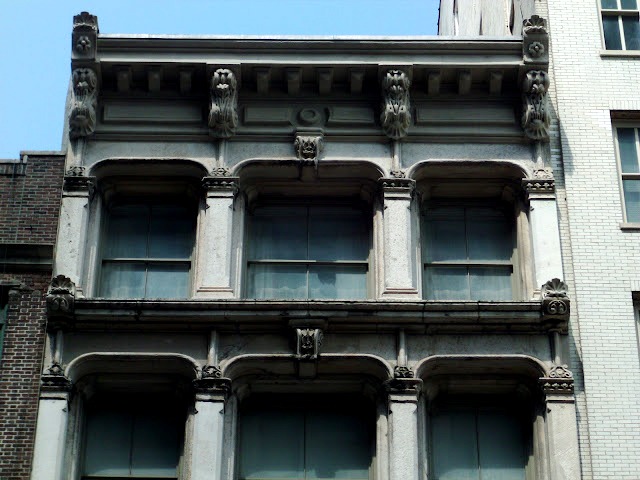SoHo Broadway is a monument to the cast-iron style of architecture. Walking up and down the corridor, once can find cast-iron buildings in different heights, colors, each with affixed columns displaying unique styles derived from classical influences. The use of cast iron to produce these building façades was a cost-cutting measure, as traditionally stone would be used to create many of the ornamental features that have come to define the style. Yet, sometimes style comes full circle and the traditional material is used to imitate the modern novelty.

597 Broadway has an appearance similar to the cast-iron buildings in the district; however, it is not actually clad in cast iron. Built in 1867 by architect John Kellum, the store and warehouse that was built to replace the old Lafayette Hall employs marble to shape its façade. A more thorough description of the building can be found in the 1973 SoHo Cast Iron Historic District Designation Report:

Like most of the storefronts in SoHo, 597 Broadway has changed many hands and had many different identities throughout its 153-year history. The 1867 building was home to a dry goods store, with the upstairs tenant Theodore Roberts, a liquor dealer; unfortunately, Roberts was caught selling liquor on election day in 1867 and was arrested. Mitchell Vance & Company, manufacturers and sellers of high-end lighting fixtures, bronzes, clocks and ornamental metal work, eventually moved into the property but left in 1877. In 1885, a fire broke out in the building and ravaged the structure. Though many thought the building would be destroyed as the stores inside were wiped out, the marble survived and allowed it to be rebuilt.

In the early 20th century, political organizations moved into the building. In 1904 a Democratic organization, the Commercial Travelers’ League, was here. By the 1920s, the street level was home to the bakery and store of the Broadway Pastry Shop. Yet, in the middle of the century, 597 Broadway, like many of its cast iron contemporaries, was left mostly underutilized. In 1986, Welsh geologist Owain Hughes purchased 597 Broadway with the intention of converting it to six commercial and nine residential condominiums. After initially scanning the façade he described the material as “sandstone,” but upon cleaning and restoration was surprised to find gleaming white marble.
These days, the storefront of 597 Broadway has seen occupation by multinational brands that have come to dominate the corridor, most recently being home to a Billabong. These days, the unique yet ubiquitous style of 597 Broadway means that the building is often times mistaken for painted cast iron instead of read as marble.